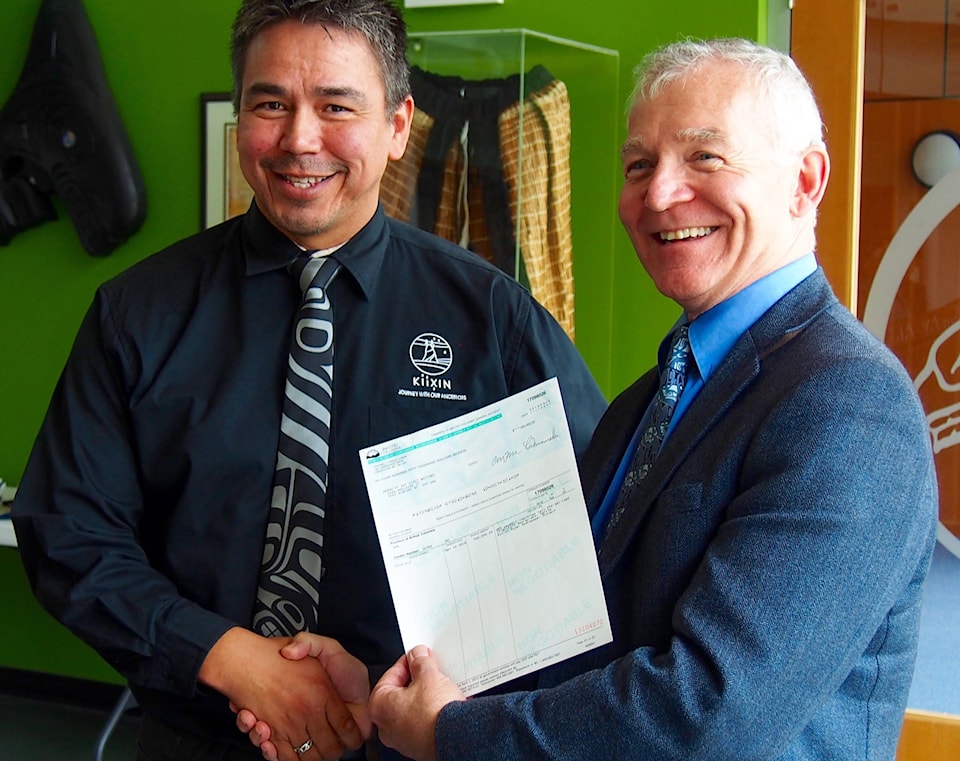MIKE YOUDS
SPECIAL TO THE NEWS
Huu-ay-aht First Nations believe they are closer to realizing a long-held ambition — a $20-million independent power project (IPP) on the Sarita River.
Band councillors outlined the project’s status Friday, May 4 at the Anacla Government Office in Anacla, where Mid Island-Pacific Rim MLA Scott Fraser, Minister of Indigenous Relations and Reconciliation, presented them with a cheque for $450,000.
The clincher for the project, however, would be an electrical purchase agreement with B.C. Hydro. The Crown corporation announced in March it has a standing offer with five First Nations, including HFN, to proceed with electrical purchase agreements for their IPPs.
Executive Councilor Trevor Cootes, whose portfolio includes economic development, said developing “clean energy,” along with forestry and tourism, has been a top priority in recent years. They’ve spent nine years bringing the five-megawatt run-of-river project to this stage, working in partnership with the renewable energy firm Barkley Project Group.
“As a power provider it will generate approximately $2.2 million per year in sales of electricity to B.C. Hydro,” Cootes said. “We have a complete project design and we have received all of our regulatory permits.”
The generating station could provide more secure power to the entire area — they are subject to storm-related outages in winter — while generating enough surplus electricity to sell to Hydro. They hope to see the project completed by 2020.
“We’re working with B.C. Hydro to get an electricity purchase agreement in place and that will provide us with market security and provide long-term viability. We’re currently looking at 40 years for this project,” said Cootes. This is based on turbine life but with prospects for lengthier service.
Known as the Heart of the People, Sarita River has been integral to Huu-ay-aht culture for millennia. Cootes said HFN have completed extensive rehabilitation work along the river to restore the main channel and upper reaches, important fish habitats damaged by logging in the 1950s and ’60s. The generating station will be located above the river falls with minimal impact on aquatic life and no change in the level of Sarita Lake.
Self-governance and the decade-old Maa-nulth Treaty have benefitted Huu-ay-aht, said Chief Councillor Robert Dennis Sr., placing the Sarita project in context.
“We do realize as Huu-ay-aht we’re just a little speck on the provincial radar, so sometimes we have to do things a little differently in order to be heard,” Dennis said, acknowledging the province’s assistance with a nod to the NDP government. “We’re really glad that you’re there.”
Fraser praised work done to date on the project. The First Nations Clean Energy Business Fund, source of the funding announced Friday, is an important part of providing clean energy to First Nations and benefits the region, he said.
“I just think it’s a great example of how to build a solid project plan. It’s an example to the province on how to do it right.”
Quoting from a meeting with the Carrier-Sekani First Nation in Prince George, Fraser said he liked the idea of partnerships “doing constructive damage to the status quo.”
“We have to change the way we work together with government-to-government relationships and true partnerships,” he said.
Wiisqi, speaker for the Kiix-in, one of 13 Huu-ay-aht communities, welcomed visitors to Huu-ay-aht by leading in song a group that included band councillors and the MLA.
